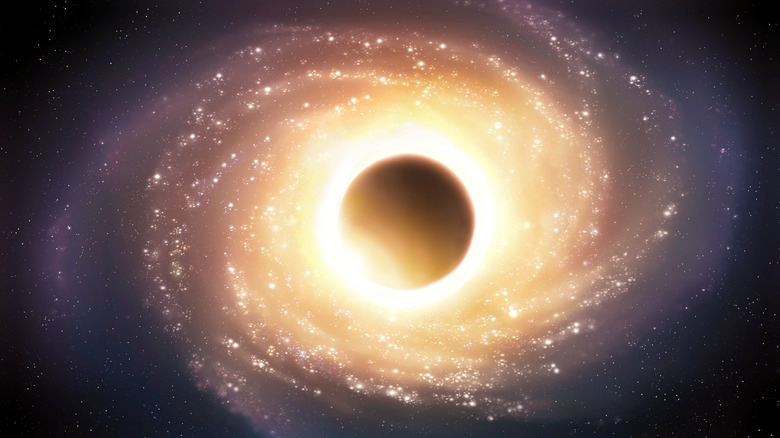A Galaxy Far Away Has 140 Trillion Times The Amount Of Water As On Earth (& It's All Vapor)
Quasars are some of the most extreme objects in the universe. Originally termed quasi-stellar radio sources, these incredibly bright cosmic objects occur when large amounts of matter such as gas, dust, stars, and planets fall into a supermassive black hole. The black holes are found at the center of large galaxies and can weigh anywhere from several million to tens of billions of times the mass of our sun. The extreme gravity and friction caused by the black hole causes all the matter spiraling around it to heat up by millions of degrees, making it luminous to the point that the quasar outshines the galaxy in which it sits. In fact, quasars are so bright, they can be between 10 to 100,000 times the brightness of our Milky Way galaxy.
The closest quasars to us are still hundreds of millions of light-years away, and since the light they emit takes so long to reach us, we're only able to see them as they were much earlier in the life of the universe. This is important, as it means quasars provide a glimpse at the universe as it was in its early stages, allowing scientists to study the nascent cosmos. One such example is APM 08279+5255, a quasar that sits 12 billion light years away from our planet. The black hole at the center of this particular quasar is 20 billion times the mass of our sun, but that's not necessarily the most exciting thing about it. APM 08279+5255 is also home to the largest and farthest reservoir of water yet discovered in the universe.
The vast water reservoir sitting billions of light years across the universe
In 2011, scientists at NASA's Jet Propulsion Laboratory in Pasadena, California, lead by Matt Bradford, studied APM 08279+5255 and its black hole alongside a separate team of astronomers. They published their findings in The Astrophysical Journal Letters, revealing the discovery of a water reservoir holding 140 trillion times the water on all of Earth. This vast deposit of water is held within the quasar itself, and spans a region that measures hundreds of light-years across (one light-year is roughly 6 trillion miles).
Making this remarkable discovery involved one group of astronomers using the Plateau de Bure Interferometer in the French Alps and finding hints of water in APM 08279+5255 via a single signature. Using a 33-foot telescope known as the "Z-Spec," a second group of researchers then confirmed their findings, which they later double-checked using radio dishes. This process provided confirmation that the multiple signals detected gave an accurate sense of the scale of the quasar's plentiful water vapor.
Due to the unique conditions created by the supermassive black hole at the center of this quasar, the water vapor sits in an extreme environment where the temperature is minus 81.4 degrees Fahrenheit and the density of the vapor is 100 times greater than in similar regions observed in the universe. By comparison, in our solar system, water is typically found in liquid or frozen form. Jupiter's moon Europa, for example contains water in the form of ice while Saturn's moon Enceladus has a subsurface ocean beneath an icy surface. There's even ice on Mars, which experts believe could be hiding an exciting secret. The water in APM 08279+5255, however, is pure vapor.
Water vapor from the start of our universe
Since this incredible discovery is 12 billion light-years away, that means the light we're seeing is being beamed from the early age of the universe, which in turn means that this water reservoir existed at that time. That's a big deal because it demonstrates that water was present throughout the universe from the very beginning. A 2025 paper published in Nature Astronomy even suggests that water was present when the first galaxies were formed.
Discovering water anywhere in the universe is a major development because it is such an important ingredient for the emergence of life. In its search for extra-terrestrial life, NASA typically looks for liquid water simply because following the water is such a reliable method for the discovery of life on Earth. As such, the presence of water in APM 08279+5255 tells us that elements required for the emergence of life have been around for a significant amount of time. Astronomers always thought that water vapor would have been present during this early period but this is the first time it has been detected this far away.
But it's not just that water is such a crucial ingredient for life. The discovery of this vast reservoir also tells us much about how galaxies formed and changed as the universe developed. Water is involved in the creation and development of stars and galaxies, helping gas clouds cool and collapse more easily. This ultimately leads to new stars being created, and in the case of APM 08279+5255 we have the largest reservoir of water yet discovered in the universe in a place where astronomers weren't expecting to find it. That tells us that this area 12 billion light-years away is not a cold empty space, but a warm, dense, active section of the cosmos, providing an insight into how the universe itself evolved and filling in more gaps in our understanding of the cosmos.


